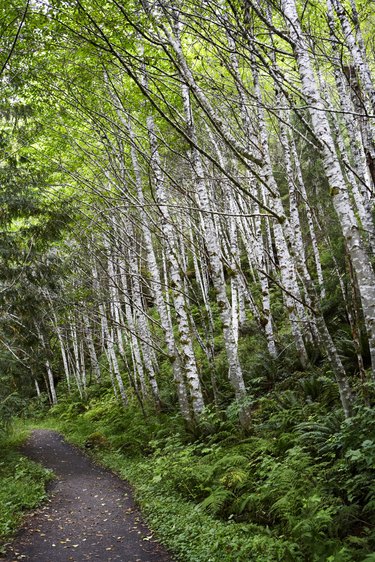
Paper birch (Betula papyrifera) grows wild in parts of the Pacific Northwest and is commonly grown in home landscapes throughout the region in U.S. Department of Agriculture plant hardiness zones 2 through 9. The peeling white bark and pyramidal growth habit make this one of the most stunning specimens for Northwest gardeners. The trees are right at home in the cool, moist zones of the Northwest, but the planting site needs to be carefully considered to provide the right the conditions for healthy, vigorous growth.
Landscape Use
Video of the Day
Paper birches make elegant shade trees and look best when planted in small groves of closely spaced trees, as they are found in the wild. They cast a light, dappled shade that is made even brighter by the white bark and light green hue of the leaves. They are a good fit with the palette of moisture-loving plants common in Pacific Northwest gardens. They can also be grown as a single specimen with one or multiple trunks and will eventually reach 70 feet in height.
Video of the Day
Growing Conditions
Paper birches are tolerant of a wide variety of soil types as long as they are kept moist. The roots form wide mats just beneath the surface and are quite averse to the hot sun. The canopy thrives in full sun, but the root system needs afternoon shade. The cool, moist areas west of the Cascade mountains are very favorable to the establishment of paper birches, but the heat and dry conditions east of the Cascades means extra care and attention is needed in site selection and care for paper birches to perform well.
Pests and Disease
The Pacific Northwest is one of many regions in the country where the bronze birch borer has become a significant pest. Stressed trees are most susceptible to attack, especially those suffering from hot and dry conditions. Serious infestations cause the rapid decline and death of paper birches. Aphids and the black sooty mold often associated with them is also common, but is usually not life-threatening. In this case, the damage is largely cosmetic, leaving a sticky black residue on any surface under the tree -- a nuisance when they are planted over parking areas and pathways.
Alternative Species
Because it is so well-adapted to landscape applications, the White-Barked Himalayan Birch (Betula utilis) is more commonly grown in the Pacific Northwest and is hardy in USDA zones 4 to 7. It has very similar characteristics overall, though it is smaller in stature, growing 40 feet tall and 20 feet wide. River birch (Betula nigra) is highly resistant to the bronze birch borer and is a great alternative to paper birch where this pest is a problem. River birches have a similar appearance, but the bark is tan-colored rather than white.